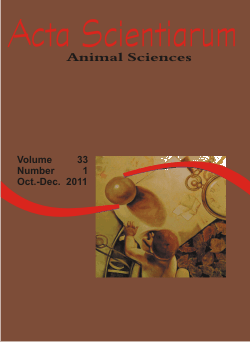<b>Evaluation of inulin and probiotic for broiler chickens</b> - doi: 10.4025/actascianimsci.v33i1.9979
Keywords:
Antibiotic, performance, prebiotic, symbiotic
Abstract
The objective of this work was to evaluate the effects of growth promoter additives (prebiotic, probiotic and symbiotic) as an antibiotic replacement on the performance and carcass characteristics (prime cuts, organs and abdominal fat) in diets for broiler chickens 1 to 42 days old. A total of 384 birds were used, one-day-old, on a reused bed. A completely randomized design was used, with four treatments and six replications, namely: PRO - supplementation with probiotic (2 kg t-1), ANT - supplementation with antibiotics (flavomycin 10% - 4 ppm and halquinol 60% - 15 ppm), PRE - supplementation with prebiotic (5 kg t-1), SIMB - supplementation with probiotic and prebiotic (2 and 5 kg t-1, respectively). The probiotic used consisted of Lactobacillus acidophilus, Streptococcus faecium and Bifidobacterium bifidum, and the prebiotic used consisted of inulin (chicory root extract). In the initial phase, the chickens fed diets containing probiotic and symbiotic had higher weight gain and total weight at 21 days. Supplementation with antibiotics in feed provided a lower feed intake at 1 to 21 days old. The growth promoters did not show an effect on the variables of performance, carcass yield and prime cuts studied in the phase from 1 to 42 days of age.Downloads
Download data is not yet available.
Published
2011-02-02
How to Cite
Silva, W. T. M. da, Nunes, R. V., Pozza, P. C., Pozza, M. S. dos S., Appelt, M. D., & Eyng, C. (2011). <b>Evaluation of inulin and probiotic for broiler chickens</b> - doi: 10.4025/actascianimsci.v33i1.9979. Acta Scientiarum. Animal Sciences, 33(1), 19-24. https://doi.org/10.4025/actascianimsci.v33i1.9979
Issue
Section
Nonruminant Nutrition
DECLARATION OF ORIGINALITY AND COPYRIGHTS
- I Declare that current article is original and has not been submitted for publication, in part or in whole, to any other national or international journal.
The copyrights belong exclusively to the authors. Published content is licensed under Creative Commons Attribution 4.0 (CC BY 4.0) guidelines, which allows sharing (copy and distribution of the material in any medium or format) and adaptation (remix, transform, and build upon the material) for any purpose, even commercially, under the terms of attribution.
Read this link for further information on how to use CC BY 4.0 properly.
0.9
2019CiteScore
29th percentile
Powered by 








































